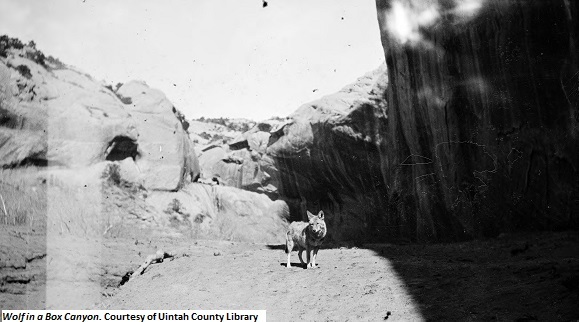Dublin Core
Title
Description
Anxiety about growing wolf populations led to over-hunting in the early 1900s that nearly eliminated wolf populations in northern Utah.
More than a hundred years ago, a massive migration of gray wolves into Utah’s northern counties sparked a full fledged battle between the wolves and another top predator—humans. The “wolf years,” as some settlers called them, were anxious times, especially for ranchers whose cattle and sheep were constantly in danger of being annihilated by roving packs of hungry carnivores.
Prior to 1915, residents of Rich County often remembered crossing paths with wolves. Wolf packs stalked settlers’ livestock often necessitating round-the-clock guards to keep an eye out for them. A brother and sister, who had to ride across a sprawling ranch in order to get to school, recalled coming upon groups of wolves on a regular basis. When this happened, remembered the children, their horse would simply stop in the road and wait for the wolves to pass before continuing on. Other Utahns from Rich County gained reputations for being skilled wolf hunters. Fred Feller, for instance, became known as an expert wolf killer at the tender age of sixteen. He netted more than a thousand dollars trapping and hunting predators. By the time he hung up his guns and wolf traps, he had killed nearly 30 wolves and more than a thousand coyotes. People like Feller could make a tidy sum with wolf and coyote pelts netting between 15 and 20 dollars apiece. The high price of skins, however, led to the near decimation of the local wolf population. By the 1920s, what wolves still remained in the Bear River Country left for more hospitable regions, and the “wolf years” came to a close.
Similar campaigns against wolves took place across Utah, as well as across the country. Since colonial times, Americans have demonized wolves and mercilessly hunted them. Yet, in recent years, the wolf has gained new allies who want to reintroduce it into its old stomping grounds. It remains to be seen whether the American wolf will once again flourish.
Creator
Source
Image: Wolf in a Box Canyon. c. early 1900s. Leo Thorne captured this shot of a wolf as it is boxed in by the rock walls of a mountain. Courtesy of Uintah County Library.
_______________
See the February 1995 collection of the History Blazer, a joint project of the Utah State Historical Society and the Utah State Centennial Commission. The History Blazer can be found on the Utah History Suite CD available from the Utah State Historical Society. Also see Jon T. Coleman, Vicious: Wolves and Men in America (New Haven: Yale University Press, 2004).

